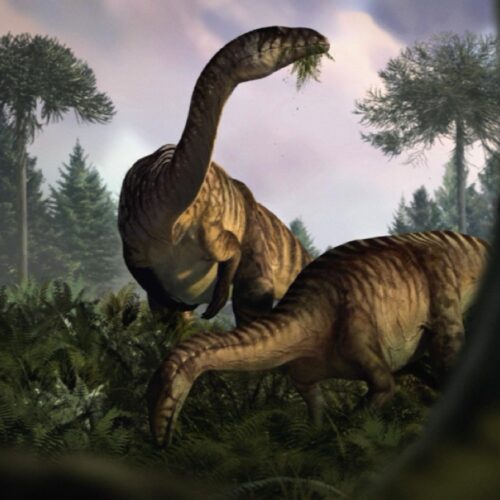The Famous, Fearsome Archaeopteryx Was More Bird Than We Knew
CT scans, UV light, and careful prep work uncovered feathers that may have given the ancient dinosaur liftoff.



What do we have in common with fish, besides being vertebrates? The types of joints we (and most vertebrates) share most likely originated from the same common ancestor. But it’s not a feature that we share with all vertebrates.
Humans, other land vertebrates, and jawed fish have synovial joints. The lubricated cavity within these joints makes them more mobile and stable because it allows for bones or cartilage to slide against each other without friction, which facilitates movement.
The origin of these joints was uncertain. Now, biologist Neelima Sharma of the University of Chicago and her colleagues have taken a look at which fish form this type of joint. Synovial joints are known to be present in jawed but not jawless fish. This left the question of whether they are just a feature of bony skeletons in general or if they are also found in fish with cartilaginous skeletons, such as sharks and skates (there are no land animals with cartilaginous skeletons).


© Rizel_S
About 252 million years ago, volcanic eruptions triggered the End-Permian Mass Extinction, also known as the Great Dying. About 96 percent of marine species were wiped out—but were things just as grim on land?
Scientists have debated whether this event caused nearly as much terrestrial destruction. Now, researchers from the Nanjing Institute of Geology and Paleontology (NIGPAS) of the Chinese Academy of Sciences suggest that terrestrial ecosystems did not suffer nearly as much as the oceans.
Led by paleontologist Feng Liu, the NIGPAS team found evidence for refugiums, oases where life thrived despite the devastation. Not only did these refugiums give life a chance to survive the mass extinction event, which lasted 200,000 years, but they are now thought to have been crucial to rebuilding ecosystems in much less time than was previously assumed.


© Corey Ford
The giant extinct shark species known as the megalodon has captured the interest of scientists and the general public alike, even inspiring the 2018 blockbuster film The Meg. The species lived some 3.6 million years ago, and no complete skeleton has yet been found. So there has been considerable debate among paleobiologists about megalodon's size, body shape, and swimming speed, among other characteristics.
While some researchers have compared megalodon to a gigantic version of the stocky great white shark, others believe the species had a more slender body shape. A new paper published in the journal Palaeontologia Electronica bolsters the latter viewpoint, also drawing conclusions about the megalodon's body mass, swimming speed (based on hydrodynamic principles), and growth patterns.
As previously reported, the largest shark alive today, reaching up to 20 meters long, is the whale shark, a sedate filter feeder. As recently as 4 million years ago, however, sharks of that scale likely included the fast-moving predator megalodon (formally Otodus megalodon). Due to incomplete fossil data, we're not entirely sure how large megalodon were and can only make inferences based on some of their living relatives.


© JJonahJackalope/CC BY-SA 4.0



Lizards are ancient creatures. They were around before the dinosaurs and persisted long after dinosaurs went extinct. We’ve now found they are 35 million years older than we thought they were.
Cryptovaranoides microlanius was a tiny lizard that skittered around what is now southern England during the late Triassic, around 205 million years ago. It likely snapped up insects in its razor teeth (its name means “hidden lizard, small butcher”). But it wasn’t always considered a lizard. Previously, a group of researchers who studied the first fossil of the creature, or holotype, concluded that it was an archosaur, part of a group that includes the extinct dinosaurs and pterosaurs along with extant crocodilians and birds.
Now, another research team from the University of Bristol has analyzed that fossil and determined that Cryptovaranoides is not an archosaur but a lepidosaur, part of a larger order of reptiles that includes squamates, the reptile group that encompasses modern snakes and lizards. It is now also the oldest known squamate.


© Lavinia Gandolfi/David Whiteside, Sophie Chambi-Trowell, Mike Benton and the Natural History Museum, London


Paleontologists have long puzzled over how the dinosaurs—originally relatively small and of minor importance to the broader ecosystem—evolved to become the dominant species some 30 million years later. Fossilized feces and vomit from dinosaurs might hold important clues to how and why this evolutionary milestone came about, according to a new paper published in the journal Nature.
Co-author Martin Qvarnström, an evolutionary biologist with Uppsala University in Sweden, and his collaborators studied trace fossils known as bromalites, a designation that includes coprolites as well as vomit or other fossilized matter from an organism's digestive tract. As previously reported, coprolites aren't quite the same as paleofeces, which retain a lot of organic components that can be reconstituted and analyzed for chemical properties. Coprolites are fossils, so most organic components have been replaced by mineral deposits like silicate and calcium carbonates.
For archaeologists keen on learning more about the health and diet of past populations—as well as how certain parasites evolved in the evolutionary history of the microbiome—coprolites and paleofeces can be a veritable goldmine of information. For instance, in 2021 we reported on an analysis of preserved paleo-poop revealing that ancient Iron Age miners in what is now Austria were fond of beer and blue cheese.


© Marcin Ambrozik